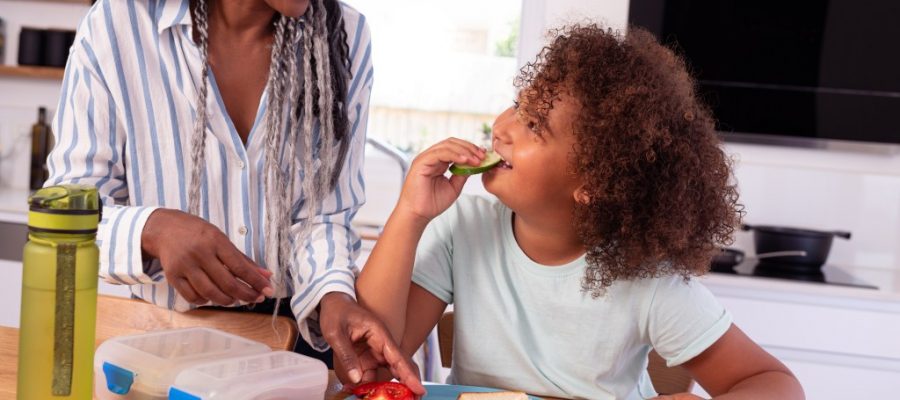If you purchase an independently reviewed product or service through a link on our website, SheKnows may receive an affiliate commission.
Getting back into the swing of school after a summer that flew by is a chore to begin with. Maybe you’re one of those parents whose favorite parts about back to school time is the lunch packing routine. Or, if you have kids with food allergies to some of the most common foods, including peanuts, tree nuts, egg, milk, wheat, soy, fish, shellfish, and sesame, school lunch can be a stressful part of the start of a new year. The good news is that it doesn’t have to be a stress-filled time for you or your children with allergies.
There are ways to be flexible with your lunch packing (leftovers for the win!), swap out foods that contain the top 9 most common allergens for allergy-safe foods, and teach your kids to advocate for themselves and keep themselves safe during lunchtime at school. We chatted with registered dietitian Elizabeth Pecoraro, MS, RDN, author of The Allergy-Friendly Cookbook: Simple Recipes for the Whole Family and food allergy expert, to learn about her best tips on making sure your kids’ lunches are healthy and allergy-free.

Read, read, read those labels.
This feels like a given if you’re a parent of children with food allergies, but keep in mind that food package labels can change over time. Peanuts and tree nuts can be dangerous allergies, but more people are now aware of those allergies and those allergens are usually clearly labeled on packaging, according to Pecoraro. Yet there are some hidden allergens that can sneak into your foods.
“Recently, sesame became the ninth top 9 allergen,” Pecoraro says. “Companies are putting sesame into products, especially bread products, that didn’t have them before.” So even if you’ve been buying a particular product for years, you should double check the food label at the store before tossing it in your cart to be safe.
Regularly check in with manufacturers.
Similar to checking the labels, manufacturers might regularly change their processes or equipment, which means there could be cross-contamination with allergens. It’s voluntary for food companies to include messages like “may contain milk, wheat, or tree nuts” or “produced in a facility that also processes almonds,” Pecoraro explains. If your child’s food allergy is severe, it would be worth it to call the manufacturers and make a list of those that have allergy-safe production facilities that can ensure there will be no cross-contamination with certain allergens.
Since this can change over time, keep tabs on these manufacturers from time to time and share with your friends who are parents of kids with allergies. Pecoraro also includes a list of her favorite allergy-friendly food companies in The Allergy-Friendly Cookbook.
Make clever swaps for top 9 allergens in some of your kids’ favorite foods.
The safest bet to avoid many of the top 9 is to cook with as many whole foods as possible. For example, if your kids love a buttery grilled cheese sandwich or rich pancakes, you can substitute butter with an equal amount of avocado in any recipe, Pecoraro says — and the healthy fats make it even more nutritious.
There are plenty of dairy milk substitutes on the market now if your children have a milk allergy, including pea milk, banana milk, and hemp milk if they also have a nut allergy. Some even come in juice box sizes that you can stick in your kids’ lunchboxes.
If any recipe calls for eggs, Pecoraro recommends swapping in mashed bananas, applesauce, or even avocado. Packing a chicken salad sandwich for a kid with an egg allergy? Use avocado instead of the mayo, she says.
Make leftovers a regular routine.
Keep your kids’ lunch options fresh (and make it easier on yourself) by packing leftovers from the night before. If there’s a go-to pasta or salad dish you know is allergen-free, put that in their bento box with some fruits and veggies. Pecoraro also suggests packing hearty soups in a Thermos for your kids — many are packed with whole foods, and you can add whatever ingredients you want.
Get kids in the kitchen with you.
The best thing that you can do while packing lunches is making food exciting and getting creative with it. “Make packing lunch fun: Get them involved and in the kitchen with you,” Pecoraro says. “Getting them to understand where food comes from will help them later in life.”
It’s also important to focus on the positive and the foods that they can have, so that having lunch at school and having food allergies in general doesn’t become stressful, Pecoraro advises. There are so many ways to swap out allergens for other delicious foods and still give your kids the foods they enjoy.
Teach kids with allergies to self-advocate.
Having food allergies can be socially ostracizing for some kids, especially if they have to sit at different tables during lunchtime at school. Pecoraro suggests creating a safety plan with your child’s school that feels comfortable for you and your children. At one point her daughter, who has a number of severe food allergies, chose to sit at the end of a lunch table once she got older, and the person sitting directly next to her would not have nuts in their lunch to make sure it was safe. The lunch monitor at the school helped to enforce that system.
Even if your kids are young and just starting out in school, encourage them to advocate for themselves (as long as the school staff is also well-informed). “It can’t be silent or can’t be a secret that they have a food allergy,” Pecoraro says. “It also doesn’t define them and they need to be vocal about it.”
Before you go, pick up these natural products to fight those back-to-school colds:

Source: Read Full Article

